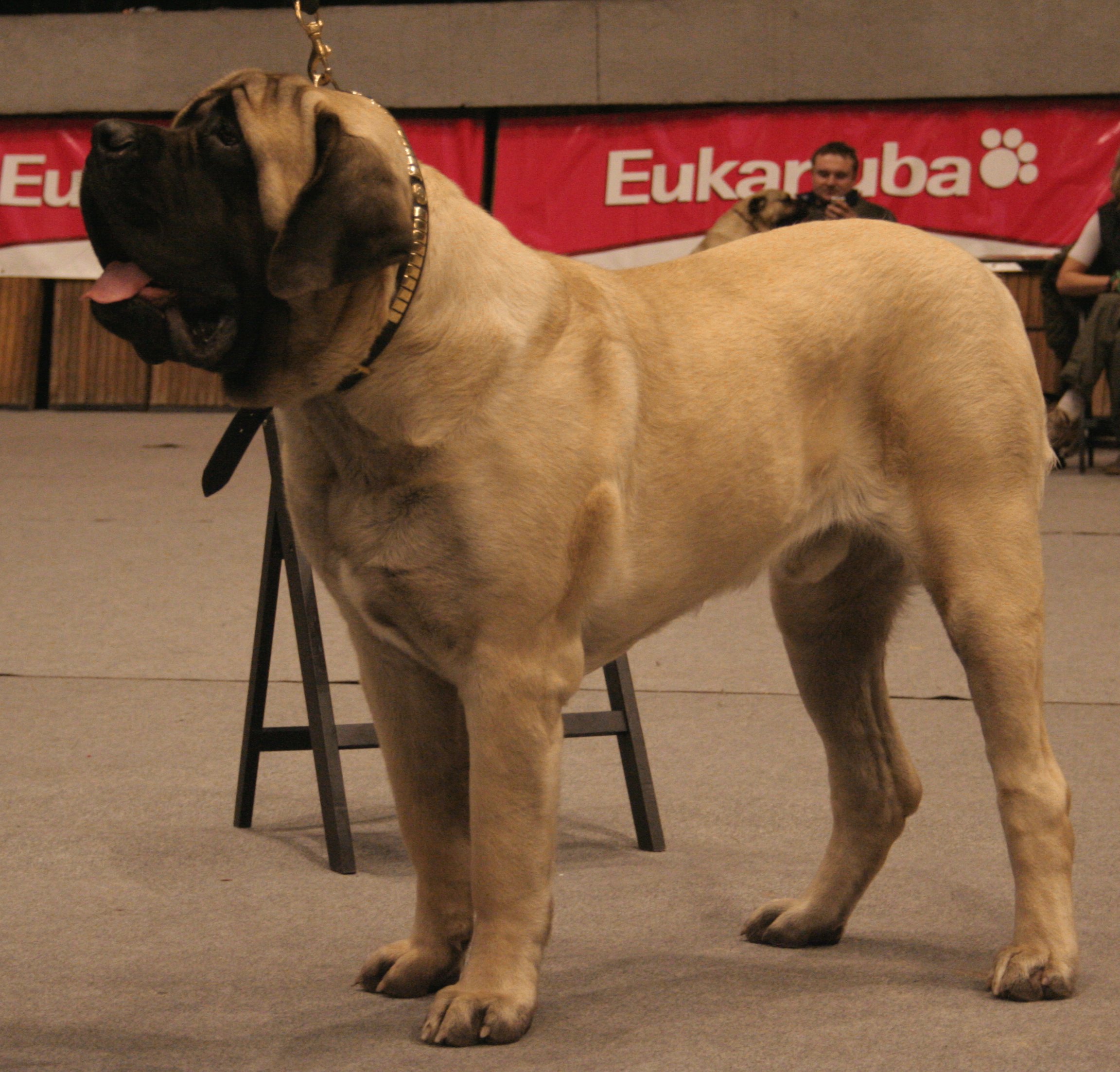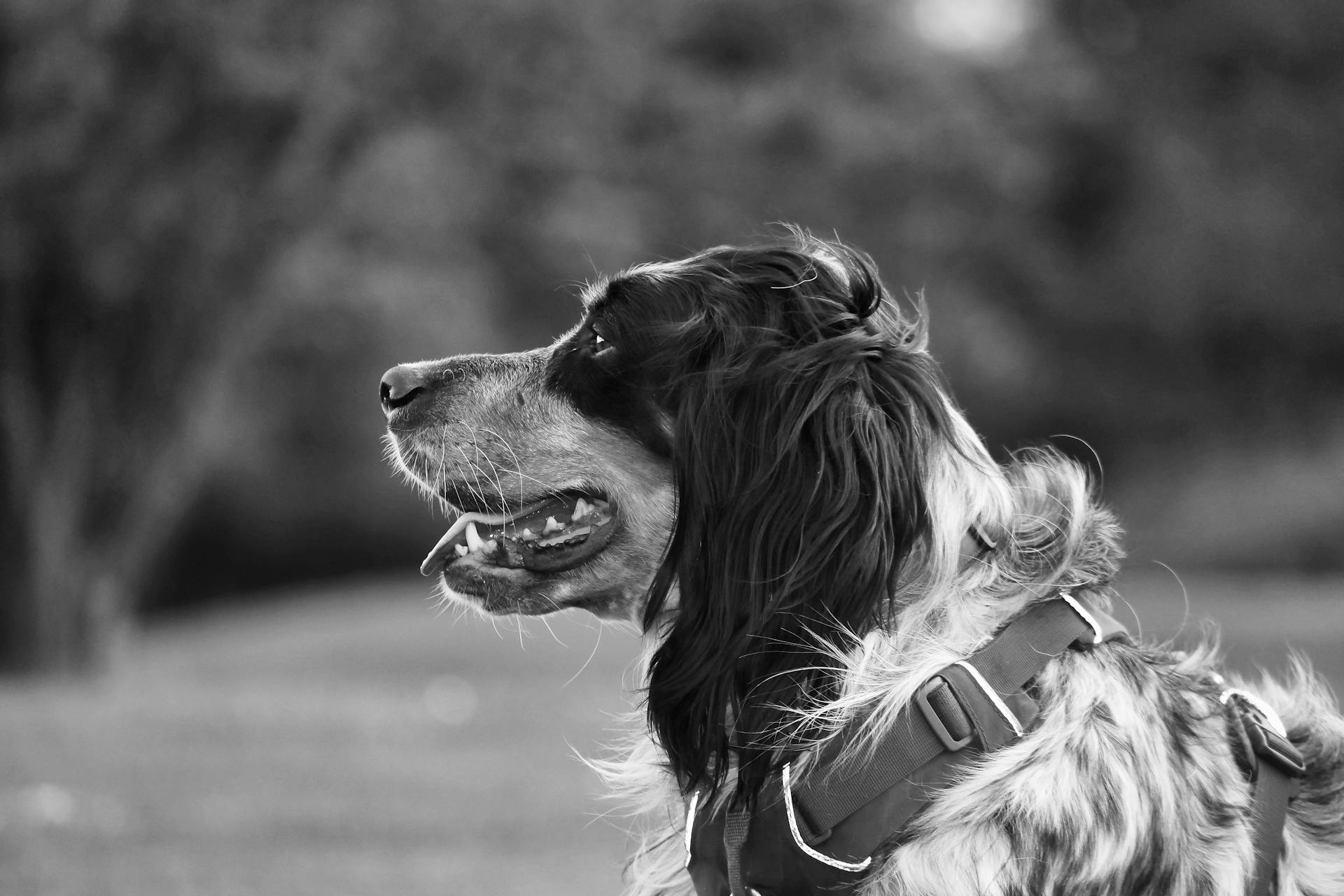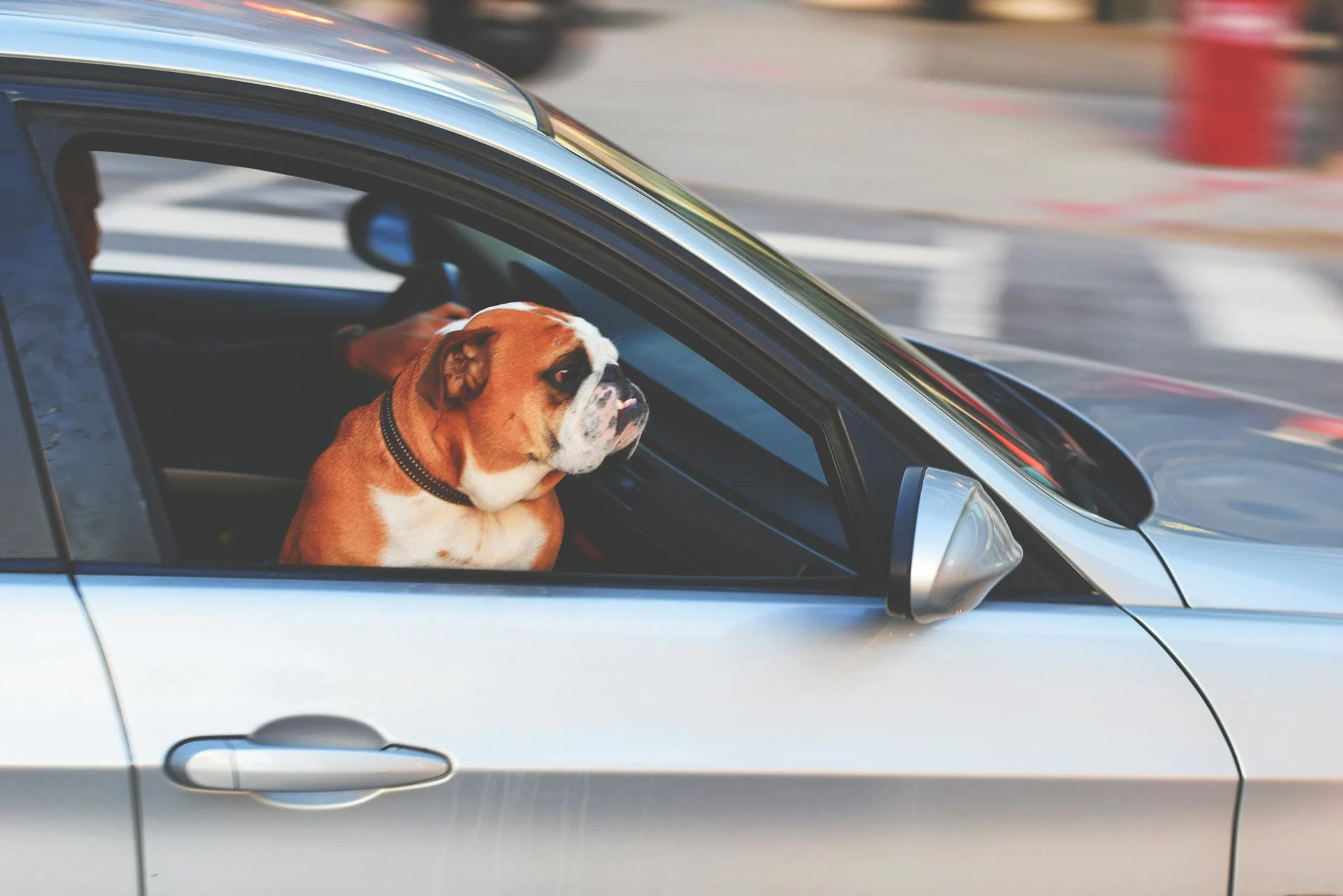
Welcoming a new English Mastiff puppy into your family can be a life-changing experience. English Mastiff puppies are known for their gentle giant reputation, weighing up to 230 pounds and standing as tall as 30 inches.
Their massive size requires a lot of space to move around, making a spacious home with a large yard a must. English Mastiff puppies need regular exercise to stay healthy and happy, but their short coats require minimal grooming.
English Mastiff puppies are relatively slow to mature, taking up to two years to reach full size. This means they'll need plenty of patience and love as they grow and develop their personalities.
Breed Characteristics
English Mastiff puppies are known for their gentle nature, which makes them a great choice for families with children.
They are also relatively quiet, with a short, deep bark that's not too loud.
English Mastiff puppies are massive, with males weighing up to 230 pounds and standing as tall as 30 inches.
Their short coats are easy to maintain, requiring only occasional brushing and a bath every few months.
Despite their size, English Mastiff puppies are relatively low-maintenance when it comes to exercise, needing only short walks and playtime each day.
Their calm and even-tempered nature makes them a great choice for first-time dog owners.
Health and Care
English Mastiff puppies require regular exercise to discourage slothful behavior and prevent health problems, but excessive running is not recommended for the first 2 years of their life to avoid damaging growth plates in their joints.
Their large size means they may be prone to being smothered or crushed by their mother during nursing, so a whelping box and careful monitoring can prevent such accidents.
Mastiff puppies may grow rapidly, gaining over 5 pounds in just a few weeks, so a balanced diet and regular exercise are crucial for their development.
To prevent health problems, regular exercise must be maintained throughout the dog's life, and a soft surface is recommended for them to sleep on to prevent the development of calluses, arthritis, and hygroma.
For your interest: Pug Dog Lifespan
Some common health issues in Mastiffs include hip dysplasia, gastric torsion, obesity, and osteosarcoma, so it's essential to work with a responsible breeder who screens for these conditions.
To keep your Mastiff healthy, consider the following tips:
- Feed your Mastiff 2-3 meals per day, instead of one big meal, to prevent gastric torsion.
- Avoid exercise around mealtimes to reduce the risk of bloat.
- Use a soft surface for your Mastiff to sleep on to prevent calluses, arthritis, and hygroma.
Regular eye care is also crucial for Mastiffs, as they are prone to numerous eye conditions, so monitor their eyes regularly and clean them routinely to prevent tear stains and infections.
Health Issues
Mastiffs are prone to a range of health issues due to their large size and rapid growth rate. They can gain over 5 pounds in just a few weeks, which can put a lot of strain on their joints.
Regular exercise is essential to prevent slothful behavior and various health problems, but excessive running is not recommended for the first two years of a Mastiff's life to avoid damaging their growth plates.
A Mastiff's diet should consist of regular, balanced meals, with two or three daily feedings recommended. Feeding them one large meal per day can increase the risk of gastric torsion.
Explore further: Large Mountain Dogs

Mastiffs are also at risk of developing hip dysplasia, a condition where the bones of the hip joints don't align properly, leading to joint deterioration and loss of function. Hip dysplasia can be screened for with x-rays.
Other potential health issues for Mastiffs include obesity, osteosarcoma, and cystinuria, as well as less common problems like cardiomyopathy, allergies, and progressive retinal atrophy (PRA).
Here are some common health issues that can affect Mastiffs, along with their potential causes:
- Hip dysplasia: hereditary or exacerbated by exercise habits, weight, and nutrition
- Gastric torsion: increased risk with one large meal per day
- Obesity: poor diet or lack of exercise
- Osteosarcoma: genetic predisposition
- Cystinuria: genetic disorder
Caring for Large Breed Dogs
Caring for Large Breed Dogs requires special attention to their diet and exercise. A large breed dog like the Mastiff needs to be fed two or three times a day to prevent gastric torsion.
Regular exercise is crucial to prevent slothful behavior and health problems, but excessive running can damage the growth plates in the joints, so it's best to limit it for the first 2 years of the dog's life.
Expand your knowledge: English Mastiff Large
A soft surface is recommended for the dog to sleep on to prevent calluses, arthritis, and hygroma. This is especially important for large breed dogs that can gain over 5 pounds in just a few weeks.
To prevent accidents during nursing, a whelping box can be used, and careful monitoring is essential. This is because puppies may potentially be smothered or crushed by the mother due to their large size.
Here are some common health problems found in large breed dogs like the Mastiff:
- Hip dysplasia
- Gastric torsion
- Obesity
- Osteosarcoma
- Cystinuria
It's essential to test for hip dysplasia, elbow dysplasia, thyroid, and DNA for PRA when purchasing a purebred Mastiff. This will help identify potential health issues early on.
If this caught your attention, see: Bernese Mountain Dog Hip Dysplasia
Grooming and Care
English Mastiff puppies are adorable, but they require regular grooming to stay healthy and happy.
Their short, straight outer coat and dense undercoat need to be brushed weekly, with daily brushing during shedding season.
You may notice a small patch of white on their chest, but be sure to check for sores, rashes, or signs of infection on their skin, nose, mouth, eyes, and feet during these regular grooming sessions.
A Mastiff's muzzle, nose, ears, and eye rims should be dark, with black being the best, and their eyes should be clear with no redness or discharge.
Regular grooming also helps you spot potential health problems early, so make it a positive experience with praise and rewards.
Ear Care
Cleaning your Mastiff's ears is a crucial part of their grooming routine. Their ears must be cleaned after they're in water, such as after a bath or after swimming.
You'll need a veterinary-approved ear cleanser to keep their ear canals healthy.
Coat Color and Grooming
The Mastiff's coat is a beautiful thing, but it does require some regular maintenance to keep it looking its best.
Their short, straight outer coat with a dense, shorter undercoat comes in fawn, apricot, or brindle colors. Brindle Mastiffs have a fawn or apricot background color with dark stripes.
Weekly brushing with a rubber hound glove is a must, and daily brushing during shedding season can help keep flying hair under control. Some Mastiffs shed year-round, while others do most of their shedding in the spring and fall.
A stripping blade can also be helpful in removing excess hair. It's essential to start accustoming your Mastiff to being brushed and examined when they're a puppy, making grooming a positive experience filled with praise and rewards.
See what others are reading: Are Great Danes Mastiffs
Regular grooming checks for sores, rashes, or signs of infection on the skin, nose, mouth, eyes, and feet are crucial. Eyes should be clear, with no redness or discharge.
Their coat color standards include apricot-fawn, silver-fawn, fawn, or dark fawn-brindle, always with black on the muzzle, ears, and nose and around the eyes. A black mask should occur in all cases.
A unique perspective: American Staffordshire Terrier Fawn
Feeding and Nutrition
English Mastiff puppies are individuals, just like people, and they don't all need the same amount of food. A highly active puppy will need more than a less active one.
The quality of dog food you buy makes a difference - the better the food, the further it will go toward nourishing your puppy. Feed your Mastiff puppy a large-breed puppy food approved by the Association of American Feed Control Officials (AAFCO).
Mastiffs are prone to gastric torsion, also known as bloat, so it's essential to feed them carefully. Factors contributing to bloat include eating a large meal and drinking large amounts of water, heavy exercise directly before or after a meal, giving food in raised feeding dishes, and stress.
Expand your knowledge: English Mastiff Food
Feeding your Mastiff puppy 2-3 meals per day instead of one big meal can help prevent bloat. Avoid exercise around mealtimes to minimize the risk.
Here's a general guideline for feeding your English Mastiff puppy:
As your Mastiff puppy grows, you may need to adjust their diet to prevent joint problems. For Mastiffs with growth disorders affecting their joints, such as hip dysplasia, it's beneficial to give them nutritional supplements with glucosamine and chondroitin to help keep their joints healthy.
Behavior and Training
English Mastiff puppies are known to be wary of strangers due to their history as guard dogs, so it's essential to invest in early training and socialization. This will help them become confident and calm around new people.
Mastiffs are eager to please and learn quickly, making them a joy to train with positive reinforcement methods. Training sessions should be kept short to keep their attention and focus.
To ensure your Mastiff puppy grows into a well-rounded dog, early socialization is crucial. This involves exposing them to many different people, sights, sounds, and experiences when they're young. Enrolling them in a puppy kindergarten class is a great start.
Mastiffs are generally calm and patient in the home, but they can quickly spring into action if they perceive a threat, so it's essential to teach them to respond calmly to new situations.
Here are some fun activities you can try with your Mastiff puppy:
- Pulling carts
- Obedience
- Tracking
- Search and rescue
- Lounging on the couch
Remember, Mastiffs are sensitive dogs and can become shy, fearful, or aggressive if mishandled, so it's crucial to treat them gently and with respect.
General Information
English Mastiff puppies are massive, with some weighing up to 220 pounds or more. They're considered the largest breed in the world, with a Mastiff named Zorba weighing a record 323 pounds in 1989.
Their size makes them appear fierce, but their temperament is actually one of good-natured docility. They're kind, dignified, and courageous, and love being with people.
If you're considering bringing an English Mastiff puppy into your home, it's essential to consider their needs. They require adequate exercise, and can make themselves at home in any environment, from a city condo to a country estate.
Here are some key characteristics to keep in mind:
- Impressive Size: English Mastiffs can weigh up to 220 pounds or more.
- Gentle Temperament: Despite their size, they're known for their gentle and affectionate nature.
- High Maintenance: They require regular grooming, including wiping away drool and dealing with flatulence.
- Short Lifespan: English Mastiffs have a relatively short lifespan, which can be heartbreakingly short.
Overview
The English Mastiff is a massive breed, weighing in at 220 pounds or more, with some individuals reaching an astonishing 323 pounds. They're the largest breed in the world, and their size is truly impressive.
Despite their intimidating stature, Mastiffs are known for their gentle and affectionate nature. They're often referred to as "gentle giants" due to their calm and friendly demeanor.
Mastiffs have a rich history, dating back to the Molossian war dogs of Greece and serving in the Roman Empire during warfare. They've come a long way since then, and today they make excellent companions and protective members of the household.
Here's an interesting read: Are Rottweilers Mastiffs

One of the most important things to consider when bringing a Mastiff into your family is their size. They need plenty of space to move around, and their great size can contribute to their lifespan, which can be heartbreakingly short.
Here are some key facts to keep in mind:
- Weight: 220 pounds or more
- Historical roots: Molossian war dogs of Greece and Roman Empire
- Temperament: Gentle and affectionate, with a calm and friendly demeanor
- Lifespan: Can be short due to their size
Mastiffs are highly loyal to their families and make excellent companions. With proper training and socialization, they can be well-behaved family members.
History
The Mastiff breed has a rich history that spans thousands of years. They originated from the ancient Molosser, a type of dog that likely originated in the mountains of Asia, perhaps in Tibet or northern India.
Their ancestry can be seen in many modern breeds, including the Tibetan Mastiff, Saint Bernard, Rottweiler, Dogue de Bordeaux, and Pug. Depictions of Mastiff-type dogs appear in human records throughout the ages, in Egyptian, Babylonian, and classical Greek civilizations.
Mastiff-type dogs were used for guarding, war, and entertainment for millennia, being pitted against lions and other fierce animals. They were prized for their size and courage, and were used by famous leaders such as Kublai Khan and Hannibal.

The modern Mastiff was developed in England, where they guarded estates and patrolled the grounds at night. Lyme Hall was famous for its strain of Mastiffs, which were bred from the 15th century through the early 20th century.
During World Wars I and II, food shortages made it impossible to feed Mastiffs, and the breed almost died out. However, a pair of Mastiff puppies imported from Canada after World War II helped bring them back from the brink.
In the British Isles during World War II, virtually all Mastiff breeding stopped due to the rationing of meat. After the war, only a single bitch puppy, Nydia of Frithend, reached maturity, and her sire had to be declared a Mastiff by the Kennel Club due to unknown parentage.
In the late 1950s, Mastiffs in Britain were descended from Nydia and a small group of Mastiffs that survived the war, with each all-male bloodline going back to Ch. Crown Prince.
Suggestion: Straight Backed German Shepherds
Breed Organizations
Reputable breeders are committed to breeding healthy, well-socialized puppies that will make great companions.
They will screen their breeding stock for health problems, and provide you with lifetime support.
Backyard breeders are more interested in making a profit than in producing healthy, well-adjusted dogs.
Puppies from backyard breeders are more likely to have health problems and behavioral issues.
It's essential to find a reputable breeder to ensure you're getting a healthy and well-socialized puppy.
Expand your knowledge: Healthy Bull Terrier
Pet Care Considerations
English Mastiff puppies are a joy to have around, but they do require some special care. They're generally lazy, but this doesn't mean they don't need regular exercise.
Their short, dense coats don't require much grooming, but they do shed moderately. You'll want to have a brush on hand to keep their coat looking its best.
Mastiffs are notorious droolers, so be prepared to have a rag handy for quick cleanups. It's not uncommon to find a puddle of drool on the floor, but it's just a part of life with a Mastiff.
Before bringing home an English Mastiff puppy, consider your space and budget. They need lots of room to exist comfortably, so a small apartment might not be the best fit.
Big dogs like Mastiffs require a lot of food, which can be expensive. Be prepared to budget for the cost of feeding your new furry friend.
Socialization is key when it comes to English Mastiff puppies. They can be wary of strangers, but with proper training, they'll learn to be gentle giants.
Frequently Asked Questions
How much is an English Mastiff puppy?
English Mastiff puppies typically cost between $1,500 to $4,000, depending on the breeder and location. Researching a reputable breeder is crucial to ensure you're getting a healthy puppy
Is the English Mastiff a good family dog?
The English Mastiff is a loving and affectionate breed, suitable for families with older children, but may not be the best fit for households with toddlers due to its large size. With proper care and socialization, it can make a loyal and gentle companion for the right family.
How big can English mastiffs get?
English mastiffs can reach heights of up to 36 inches and weigh between 120-230 pounds, depending on their sex. Learn more about the breed's size and other fascinating facts.
How long do English Mastiffs live?
English Mastiffs typically live between 6-10 years, a relatively short lifespan compared to other breeds. Understanding their life expectancy can help you prepare for the responsibilities of owning one.
Featured Images: pexels.com


